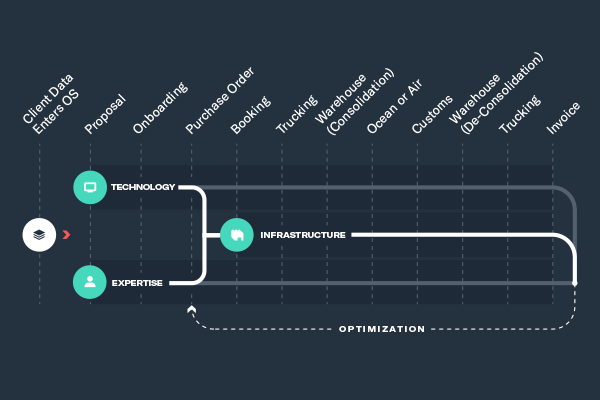We all know freight forwarding is a highly complex industry. Moving a single pallet of goods is a relay race that involves handoffs between myriad separate and largely disconnected logistics vendors. Incredibly, today this process is still handled mostly by email, phone, paper, and even fax.
Adding to the intense complexity, there are countless nonstandard documents in circulation worldwide, not to mention customs requirements vary from country to country and product to product.
The result is an antiquated customer experience for businesses moving goods across the globe. With legacy freight forwarding processes, customers have had limited visibility and insight into the status of their critical and time-sensitive shipments as they travel from origin to destination. Additionally, freight transit times are unpredictable, and costs can easily spiral out of control. All of this causes frustration and sometimes even fiscal damage to their businesses.
Freight forwarding is centuries-old, $2 trillion industry sorely in need of transformation. Of the top freight forwarders in the world based on volume, none could be considered Internet-native. As a result, the industry is now scrambling now to adapt legacy technology systems to the modern age.
Alternatively, digital freight forwarders and customs brokerages like Flexport are taking a new, tech-centric, yet human-powered, approach that is helping to enable control, efficiency, and transparency across the supply chain.
The Operating System for Global Trade: More Than Tech, A New Way to Do Business
Flexport has launched what is calls the Operating System for Global Trade – a strategic operating model for global freight forwarding that combines advanced technology and analytics, logistics infrastructure, and hands-on supply chain expertise, all delivered via a highly-available and secure cloud software platform. This unique offering unifies and simplifies the freight forwarding experience for customers and their partners, giving them deep, real-time visibility and insight into what was previously a “black box” experience.
The Operating System for Global Trade comprises:
Technology: Only Flexport connects all the parties in global trade – importers, exporters, trucking companies, ocean carriers, airlines, customs agencies, port terminals – through a single, secure cloud-based platform.
Infrastructure: In addition to offering access to all modes of transport, Flexport is building cross-docking warehouses near all major global population centers, each connected by high-frequency air, ocean, truck, and rail freight line-hauls in a global hub-spoke network.
Expertise: Flexport delivers dedicated human support, in which customers can interact with a core team of operations, customs and data professionals. Flexport also offers additional expert services such as Cargo Insurance, Trade Finance, and Customs Brokerage.
Importantly, the Operating System for Global Trade unifies a customer’s supply chain ecosystem, allowing customers to bring their manufacturers and suppliers onto the platform, simplifying and dramatically improving the performance of their global supply chains.
At the core of the Operating System for Global Trade is data, which Flexport uses to deliver a dramatically better customer experience, greatly increased operational efficiency, and deep insight and visibility.
The value Flexport and the Operating System for Global Trade bring to customers and their partners is clear and highly strategic:
- Deep visibility and control, from origin to destination
- Faster and more reliable transit times
- Lower and more predictable supply chain costs
- A secure and compliant platform you can trust
It’s time for a change.
Much of the world has gone from an old economy to a digital economy; but the supply chain hasn’t kept up. Consumers were once fine with a three-week delivery window, but now they’re in control and want their goods in days (or even hours). Businesses can’t manage a new economy supply chain by email and spreadsheets, yet that’s still the standard in freight forwarding. Flexport believes the industry needs a radically different approach. A new way to do business. An Operating System for Global Trade.
For more information on Flexport and the Operating System for Global Trade, please visit Flexport’s website.
SC
MR


More 3PL
- Services sector sees growth in October, reports ISM
- Managing inbound freight: What has changed in two decades?
- Inbound freight: Often a missed opportunity
- 2024 Warehouse/DC Operations Survey: Technology adoption on the rise
- Looking back at NextGen 2024
- Manufacturing again contracts in October, reports ISM
- More 3PL
Latest Podcast

 Explore
Explore
Business Management News
- AdventHealth named top healthcare supply chain by Gartner
- Unlocking retention: The role employee engagement plays
- Can supply chain managers embrace an entrepreneurial mindset?
- Challenges to ESG reporting
- With capacity to spare, logistics real estate demand remains subdued
- How to improve demand forecasts for new product families
- More Business Management
Latest Business Management Resources

Subscribe

Supply Chain Management Review delivers the best industry content.

Editors’ Picks




